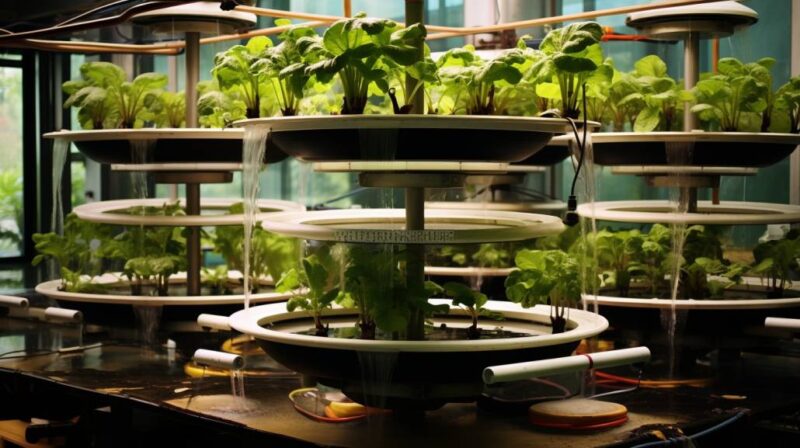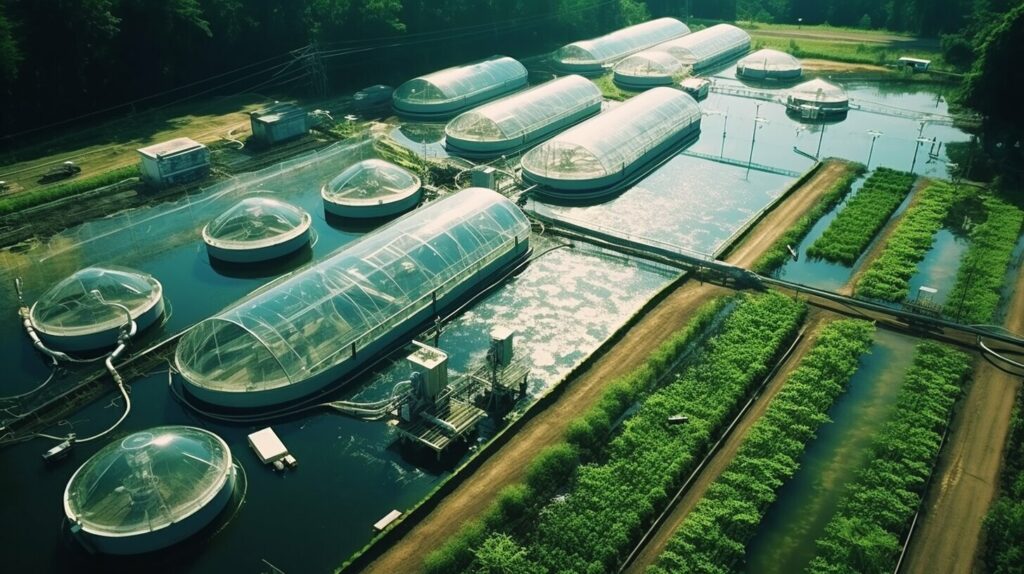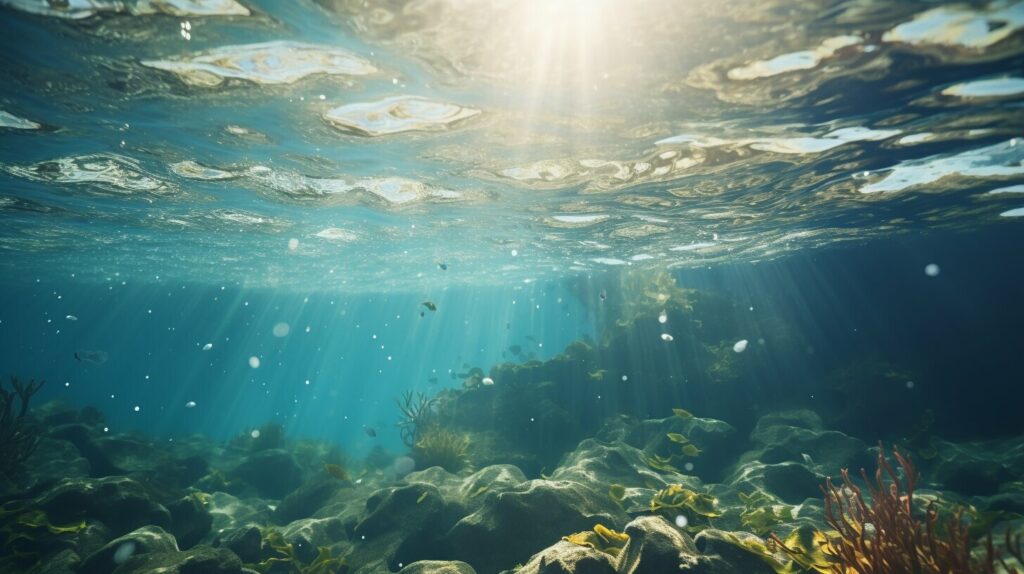This post may contain affiliate links and we may earn a small commission when you click on the links at no additional cost to you. As an Amazon Affiliate, we earn from qualifying purchases. You can read our full disclaimer here.
If you’re interested in growing your own produce and raising fish, you may have heard of aquaponics. This innovative method combines aquaculture and hydroponics to create a closed-loop system where plants and fish mutually benefit from each other’s presence.
There are several types of aquaponics systems available, each with its own unique features and benefits. In this article, we’ll explore the different types of aquaponics systems, how they work, and which one may be right for you.
Key Takeaways:
- Aquaponics is a method that combines aquaculture and hydroponics to create a closed-loop system where plants and fish mutually benefit from each other’s presence.
- There are several types of aquaponics systems available, each with its own unique features and benefits.
- Understanding the different types of aquaponics systems and the factors to consider when choosing one is essential for creating a successful aquaponics setup.
Deep Water Culture (DWC)
If you’re looking for a low-maintenance aquaponics system with minimal setup, Deep Water Culture (DWC) might be the perfect choice for you.
| Advantages: | Easy to set up | Low maintenance | Great for growing leafy greens and herbs |
|---|---|---|---|
| Disadvantages: | Not suitable for larger plants such as tomatoes or peppers | Can be prone to algae growth |
In a Deep Water Culture aquaponics system, plants are grown in a container filled with nutrient-rich water. The plants are suspended in net pots above the water, allowing their roots to grow down into the water below. An air pump and airstone are used to add oxygen to the water, which helps the plants grow.
One of the biggest advantages of DWC is that it requires very little maintenance. The only task you need to complete regularly is to top up the water level to replace any that has evaporated. Other than that, as long as your pH, ammonia, and nitrate levels are in check, you’re good to go!
DWC is particularly suitable for growing leafy greens and herbs such as lettuce, spinach, and basil. However, it may not be the best choice if you want to grow larger plants such as tomatoes or peppers.
One downside of DWC is that it can be prone to algae growth. To combat this, you can cover the container to prevent light from entering or add an algae control product to the water.
Equipment needed for a DWC system:
- Container to hold water
- Air pump and airstone to provide oxygen
- Net pots to hold plants above the water
- Growing medium to support the plants (optional)
- Aquarium heater to maintain water temperature (optional)
Overall, if you’re looking for a beginner-friendly aquaponics system that requires minimal maintenance and is great for growing leafy greens and herbs, then Deep Water Culture might be the perfect choice for you!
Nutrient Film Technique (NFT)
If you’re looking for an efficient and space-saving aquaponics system, the Nutrient Film Technique (NFT) might be just the thing for you. This system works by using a thin film of nutrient-rich water to constantly flow over plant roots, delivering nutrients and oxygen. The plants are grown in small baskets or cups, which are supported by a sloping trough.
NFT has several benefits, such as low water usage, easy maintenance, and high productivity. However, it also has some limitations that you should consider. Since the roots are exposed to the air, they can dry out quickly if the water flow stops. Additionally, the system may be vulnerable to clogging if the nutrient solution is not well-balanced.
Setting up an NFT aquaponics system is relatively simple. You’ll need a sloping trough, a pump, and some tubing to deliver the nutrient solution. You may also need a filter to remove solids and prevent clogging. The plants can be grown in baskets or cups filled with a growing medium such as coconut coir or rockwool.
| Advantages | Limitations |
|---|---|
| Low water usage | Drying out of roots if water flow stops |
| Easy maintenance | Vulnerable to clogging |
| High productivity | Needs well-balanced nutrient solution |
Media-filled Beds
Media-filled Beds is a popular type of aquaponics system that uses gravel, clay pellets, or other materials as a growing medium for plants. The media provides a habitat for microorganisms that help break down fish waste and supply nutrients to the plants. To set up a media-filled bed system, you’ll need a tank for fish, a bed filled with growing media, and a pump to circulate water between the two.
| Advantages | Disadvantages |
|---|---|
|
|
Media-filled Beds are a great option for beginners or those who want to grow larger plants like tomatoes or cucumbers. The plants can be placed directly in the media, or in pots that can be moved around the bed as needed. Maintenance is simple, and the media can be rinsed off periodically to remove any buildup of solids.
Considerations for Media-filled Beds
When choosing a Media-filled Bed aquaponics system, consider the type of media you want to use. Gravel is a popular choice, but it can be heavy and difficult to move around. Clay pellets are lighter and provide good aeration, but can be expensive. Other materials like coconut coir or peat moss can also be used.
Another consideration is the type and size of fish you want to keep. Media-filled Beds require a large tank to support the plants, which means your fish will need enough space to swim and grow. It’s also important to choose fish that are compatible with the plants you want to grow, as some may eat or damage certain types of plants.
Raft or Deep Flow Technique (DFT)
The Raft or Deep Flow Technique (DFT) is an aquaponics system that involves the use of floating rafts to grow plants on the surface of nutrient-rich water. This system is ideal for growing small to medium-sized plants, including herbs and lettuce.
How it Works
The Raft or DFT system uses a floating raft made of polystyrene or a similar material. The raft is placed on top of the water, and the plants are inserted into holes drilled in the raft. The roots of the plants dangle into the water, where they are nourished by the nutrient-rich water.
Advantages
The Raft or DFT system is easy to set up and maintain, as it requires minimal equipment and materials. The system is also cost-effective, as it uses less water than other aquaponics systems. Additionally, the Raft or DFT system produces a high yield of fresh, healthy, and nutrient-dense produce.
Disadvantages
The Raft or DFT system may not be suitable for growing large plants or crops that require deep root systems. The system may also be prone to pest and disease problems, as the plants are grown in close proximity to each other.
Considerations
When setting up a Raft or DFT system, it is important to consider the size of the rafts and the spacing between the plants to ensure adequate growth and nutrient absorption. It is also important to monitor water quality and pH levels to prevent nutrient deficiencies or excesses.
Vertical Aquaponics
If you’re short on space but still want to grow your own vegetables, vertical aquaponics might be the perfect solution for you. This system involves growing plants vertically, either on vertical towers or walls, which maximizes the use of a limited space.

There are different types of vertical aquaponics systems, including towers, A-frames, and walls. Towers are freestanding structures that can be made of PVC pipes or other materials, with plants growing from the sides. A-frames are similar to towers but have a more triangular shape. Walls can be attached to the side of a building, with plants growing out of pockets or containers.
The benefits of a vertical aquaponics system are numerous. First, it allows you to grow a large amount of produce in a compact space, making it ideal for urban gardeners. Second, it is an attractive and unique way to grow plants, adding an aesthetic value to your space. Finally, it can be easier to manage than traditional aquaponics systems, as the plants are positioned at a convenient height for tending and harvesting.
| Pros | Cons |
|---|---|
| Maximizes use of a limited space | Requires careful planning and design |
| Produces a large amount of produce | May require additional lighting if indoors |
| Attractive and unique way to grow plants | May be difficult to manage pests and diseases |
| Easier to manage than traditional aquaponics systems | May require a pump to ensure even distribution of water and nutrients |
When setting up a vertical aquaponics system, there are several things to consider. First, you’ll need to choose the right plants for your system – those that thrive in a hydroponic environment and don’t require a lot of space, such as leafy greens and herbs. You’ll also need to ensure that your system has adequate lighting and water flow, and that the plants are receiving the proper nutrients. Finally, you’ll need to be mindful of the weight of the system, as it can be heavy when fully loaded with plants and water.
If you’re looking for a space-saving, attractive, and easy-to-manage way to grow your own vegetables, a vertical aquaponics system may be perfect for you. With careful planning and design, you can create an abundant and beautiful garden in a small space.
Hybrid Aquaponics Systems
If you’re looking to get the best of both worlds, hybrid aquaponics systems may be the way to go. These systems combine two or more aquaponics techniques to create a customized setup that maximizes plant growth and fish production.

Advantages of Hybrid Aquaponics Systems
One of the primary advantages of hybrid systems is that they offer greater flexibility in terms of the types of plants and fish that can be grown. For example, you could combine the Deep Water Culture system with Media-filled Beds to grow a wider variety of plants. Hybrid systems also often lead to higher yields and a more balanced ecosystem, as they incorporate different types of filtration and water circulation mechanisms.
Popular Combinations
Some popular combinations of aquaponics systems include:
| Hybrid System | Description |
|---|---|
| DWC and NFT | Combining Deep Water Culture and Nutrient Film Technique is a popular choice that allows for more efficient use of space and optimal nutrient delivery. |
| Media-filled Beds and DFT | This combination offers the benefits of a media-based system with the simplicity and ease of a Deep Flow Technique setup. |
| Vertical Aquaponics and DWC | This combination maximizes space utilization and allows for a large number of plants to be grown in a small area. |
Design Considerations
When designing a hybrid aquaponics system, it’s important to consider factors such as available space, water source, budget, and the specific needs of the plants and fish you plan to grow. You should also take into account the maintenance requirements of each individual system, as well as how they will function together.
If you’re new to aquaponics, it’s a good idea to start with a single system before working your way up to a hybrid setup. This will give you a better understanding of how each system works and how they can be combined to create an optimal environment for your plants and fish.
Comparison of Aquaponics Systems
Now that you have learned about the different types of aquaponics systems, let’s compare them to help you choose the right one for your needs.
| Aquaponics System | Advantages | Disadvantages |
|---|---|---|
| Deep Water Culture (DWC) | Low maintenance, great for beginners, good for leafy greens | Not suitable for larger plants or heavy fruits/vegetables, requires additional aeration equipment |
| Nutrient Film Technique (NFT) | Efficient use of water and nutrients, good for small spaces, suitable for a variety of plants | Prone to clogging if not maintained properly, not suitable for larger plants or heavy fruits/vegetables |
| Media-filled Beds | Good for larger plants and heavy fruits/vegetables, provides support for plants | Requires more maintenance compared to DWC and NFT, may not be suitable for small spaces |
| Raft or Deep Flow Technique (DFT) | Efficient use of space, suitable for a variety of plants, good for larger plants and heavy fruits/vegetables | May require additional support for larger plants, not suitable for root vegetables, may require additional aeration equipment |
| Vertical Aquaponics | Efficient use of space, suitable for a variety of plants, provides a unique aesthetic | May require additional support for larger plants, may be challenging to maintain proper water flow |
| Hybrid Aquaponics Systems | Allows for customization and flexibility, combines the advantages of different systems | May be more complex to set up and maintain, may require additional equipment |
Consider your available space, desired plant output, and personal preferences when selecting an aquaponics system. Keep in mind that some systems may require more maintenance or additional equipment. Choose the system that best suits your needs and enjoy the benefits of growing your own food through aquaponics.
Factors to Consider When Choosing an Aquaponics System
Choosing the right aquaponics system can be a daunting task with so many options available. Here are some factors you should take into consideration before settling on a system:
- Available space: The amount of space you have will determine the size of aquaponics system you can set up. Consider both the footprint and height of the system when choosing a location.
- Budget: Different aquaponics systems come with varying price tags. Consider the initial cost as well as any ongoing maintenance or operating expenses.
- Skill level: Some systems may require more technical knowledge and skill to set up and maintain than others. Consider your level of experience with aquaponics and your willingness to learn new skills.
- Desired output: The type and amount of plants and fish you want to grow will influence the size and type of system you need. Consider the space and resources required for your desired output.
- Personal preferences: Everyone has their own personal preferences when it comes to aesthetics and functionality. Consider the look and feel of the system you are considering and how it matches your personal style.
By considering these factors, you can narrow down your options and choose the right aquaponics system for your needs. Remember, the perfect system is out there waiting for you, and with a little research and planning, you can find it!
Conclusion
Congratulations! You now have a good understanding of the different types of aquaponics systems available and the factors to consider when choosing the right system for your needs. Remember, selecting the right system requires careful consideration of the available space, budget, skill level, desired output, and personal preferences.
Once you have chosen the best aquaponics system for you, remember to do your research and get the necessary equipment and materials. With a little effort and dedication, you can successfully start and maintain your own aquaponics system, providing fresh produce and fish for your family all year round.




Pingback: Essential Guide to Pumps and Timers for Aquaponics
Pingback: Master Your Routine: Daily, Weekly, Monthly Tasks Simplified
Pingback: Maximizing Yield in Aquaponics
Pingback: Unlocking Best Practices for Efficient Aquaponics System Design
Pingback: Books on Aquaponics for Beginners - Aquaponics Daily
Pingback: Checklist for Aquaponics System Checks
Pingback: Is Aquaponics Expensive to Start?
Pingback: Ecological Principles of Aquaponics - Aquaponics Daily